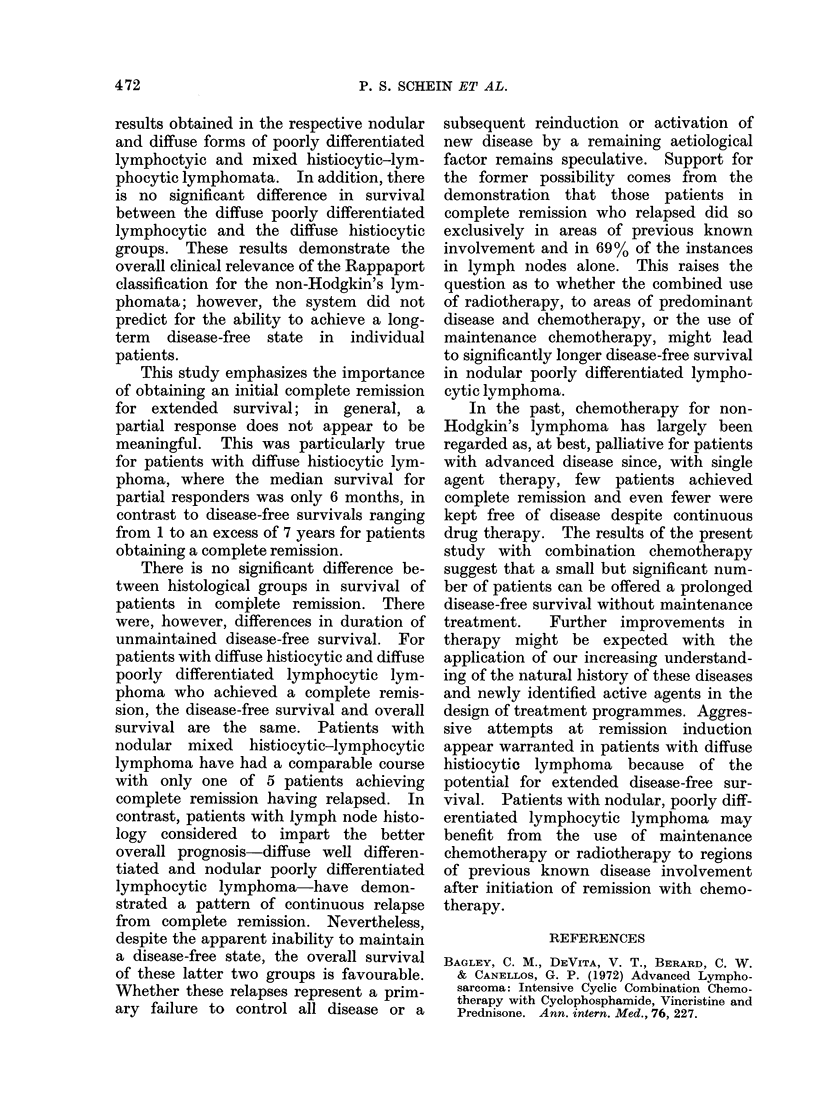Abstract
The analysis of the results of CVP and MOPP chemotherapy in 80 patients with advanced stages of non-Hodgkin's lymphoma shows that 36 achieved a complete remission. Twenty-five percent of all patients remain free of disease for periods ranging from 4 months to over 7 years, with a projected median duration of complete remissions of 3 1/2 years. Well differentiated and nodular histology were positive determinants for survival, confirming the overall clinical validity of the Rappaport classification system for the non-Hodgkin's lymphomata. However, it has been demonstrated that it is possible to achieve a complete remission using combination chemotherapy even in the most clinically aggressive histological subgroups, and that these responses can be correlated with an extended survival. An analysis of patterns of relapse from complete remission in patients with non-Hodgkin's lymphoma treated with combination chemotherapy has demonstrated differences between histological subgroups. Patients with diffuse histiocytic lymphoma who achieved a complete remission after 6 months of treatment without maintenance have remained disease-free, whereas those with nodular poorly differentiated lymphocytic and diffuse well differentiated lymphocytic lymphomata demonstrate a pattern of continuous late recurrence. The initial sites of relapse from complete remission in lymphocytic lymphoma were lymph nodes and bone marrow which were involved before treatment.
Full text
PDF








Selected References
These references are in PubMed. This may not be the complete list of references from this article.
- Bagley C. M., Jr, Devita V. T., Jr, Berard C. W., Canellos G. P. Advanced lymphosarcoma: intensive cyclical combination chemotherapy with cyclophosphamide, vincristine, and prednisone. Ann Intern Med. 1972 Feb;76(2):227–234. doi: 10.7326/0003-4819-76-2-227. [DOI] [PubMed] [Google Scholar]
- Carbone P. P., Kaplan H. S., Musshoff K., Smithers D. W., Tubiana M. Report of the Committee on Hodgkin's Disease Staging Classification. Cancer Res. 1971 Nov;31(11):1860–1861. [PubMed] [Google Scholar]
- Devita V. T., Jr, Serpick A. A., Carbone P. P. Combination chemotherapy in the treatment of advanced Hodgkin's disease. Ann Intern Med. 1970 Dec;73(6):881–895. doi: 10.7326/0003-4819-73-6-881. [DOI] [PubMed] [Google Scholar]
- GEHAN E. A. A GENERALIZED WILCOXON TEST FOR COMPARING ARBITRARILY SINGLY-CENSORED SAMPLES. Biometrika. 1965 Jun;52:203–223. [PubMed] [Google Scholar]
- HICKS E. B., RAPPAPORT H., WINTER W. J. Follicular lymphoma; a re-evaluation of its position in the scheme of malignant lymphoma, based on a survey of 253 cases. Cancer. 1956 Jul-Aug;9(4):792–821. doi: 10.1002/1097-0142(195607/08)9:4<792::aid-cncr2820090429>3.0.co;2-b. [DOI] [PubMed] [Google Scholar]
- Jones S. E., Rosenberg S. A., Kaplan H. S., Kadin M. E., Dorfman R. F. Non-Hodgkin's lymphomas. II. Single agent chemotherapy. Cancer. 1972 Jul;30(1):31–38. doi: 10.1002/1097-0142(197207)30:1<31::aid-cncr2820300106>3.0.co;2-a. [DOI] [PubMed] [Google Scholar]
- Schein P. S., Chabner B. A., Canellos G. P., Young R. C., Berard C., DeVita V. T. Potential for prolonged disease-free survival following combination chemotherapy of non-Hodgkin's lymphoma. Blood. 1974 Feb;43(2):181–189. [PubMed] [Google Scholar]


